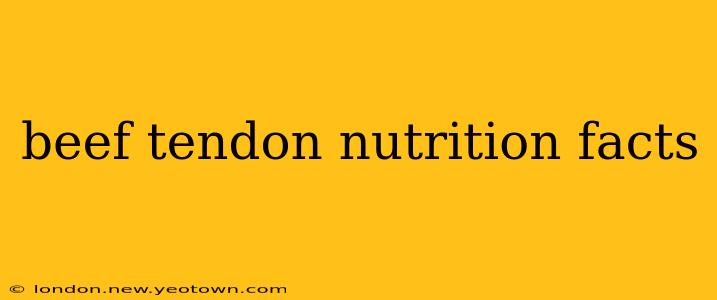Beef tendon, often overlooked in Western cuisines but a prized ingredient in many Asian dishes, is a nutritional powerhouse packed with collagen, essential amino acids, and other beneficial compounds. For those seeking to boost their collagen intake, improve joint health, or simply explore new culinary avenues, understanding the nutritional profile of beef tendon is crucial. This article delves deep into the nutritional facts of beef tendon, answering common questions and providing valuable insights into its health benefits.
What are the nutritional benefits of beef tendon?
Beef tendon is primarily composed of collagen, a type of protein that forms the structural framework of connective tissues throughout the body. This collagen content is what contributes to many of beef tendon’s nutritional benefits. It's a rich source of glycine, proline, and hydroxyproline, amino acids crucial for collagen synthesis. These amino acids aren’t just vital for healthy skin, hair, and nails; they also play a significant role in maintaining healthy joints and cartilage. Beyond collagen, beef tendon provides a modest amount of other nutrients including protein, minerals like calcium and phosphorus, and trace amounts of vitamins. It's low in fat and carbohydrates, making it a suitable addition to various diets.
How much protein is in beef tendon?
The protein content of beef tendon varies slightly depending on the preparation method and cut. However, on average, a 100-gram serving of cooked beef tendon provides approximately 15-20 grams of protein. This makes it a valuable source of protein, particularly for individuals looking to increase their daily intake, aiding in muscle building and repair.
Is beef tendon good for your joints?
Yes, the high collagen content in beef tendon is often touted for its potential benefits for joint health. Collagen is a key component of cartilage, the cushioning tissue in joints. As we age, collagen production naturally declines, potentially leading to joint pain and stiffness. Consuming collagen-rich foods like beef tendon might help to supplement this decline and support joint health, but more research is needed to solidify these claims. Always consult your doctor before using beef tendon or any other supplement for joint pain management.
What are the potential health risks associated with beef tendon?
While generally considered safe for consumption, there are some potential risks to be aware of. Beef tendon should be cooked thoroughly to eliminate any potential pathogens. Individuals with gout or other conditions affected by purines should be mindful of their intake, as beef tendon contains moderate levels of purines. As with any food, moderation is key. Excessive consumption could lead to digestive discomfort in some individuals.
How many calories are in beef tendon?
The calorie count of beef tendon also varies based on preparation. However, a 100-gram serving of cooked beef tendon typically contains around 100-120 calories. This relatively low calorie count makes it a suitable addition to weight-management diets.
Is beef tendon high in cholesterol?
Beef tendon's cholesterol content is relatively low compared to other cuts of beef. However, it’s important to consider the overall cholesterol intake from your entire diet. Individuals with high cholesterol should consult their physician before incorporating beef tendon regularly into their diet.
How can I prepare beef tendon?
Beef tendon requires longer cooking times than other cuts of meat due to its tough, fibrous nature. Slow cooking methods like braising or pressure cooking are ideal for tenderizing the tendon and making it palatable. Many Asian recipes feature beef tendon in stews, soups, and stir-fries, highlighting its versatility and flavorful potential.
This comprehensive look at beef tendon nutrition provides a clearer picture of its potential health benefits and risks. Remember that individual responses to food vary, and consulting a healthcare professional or registered dietitian is always recommended before making significant dietary changes. This information is for educational purposes only and should not be considered medical advice.

